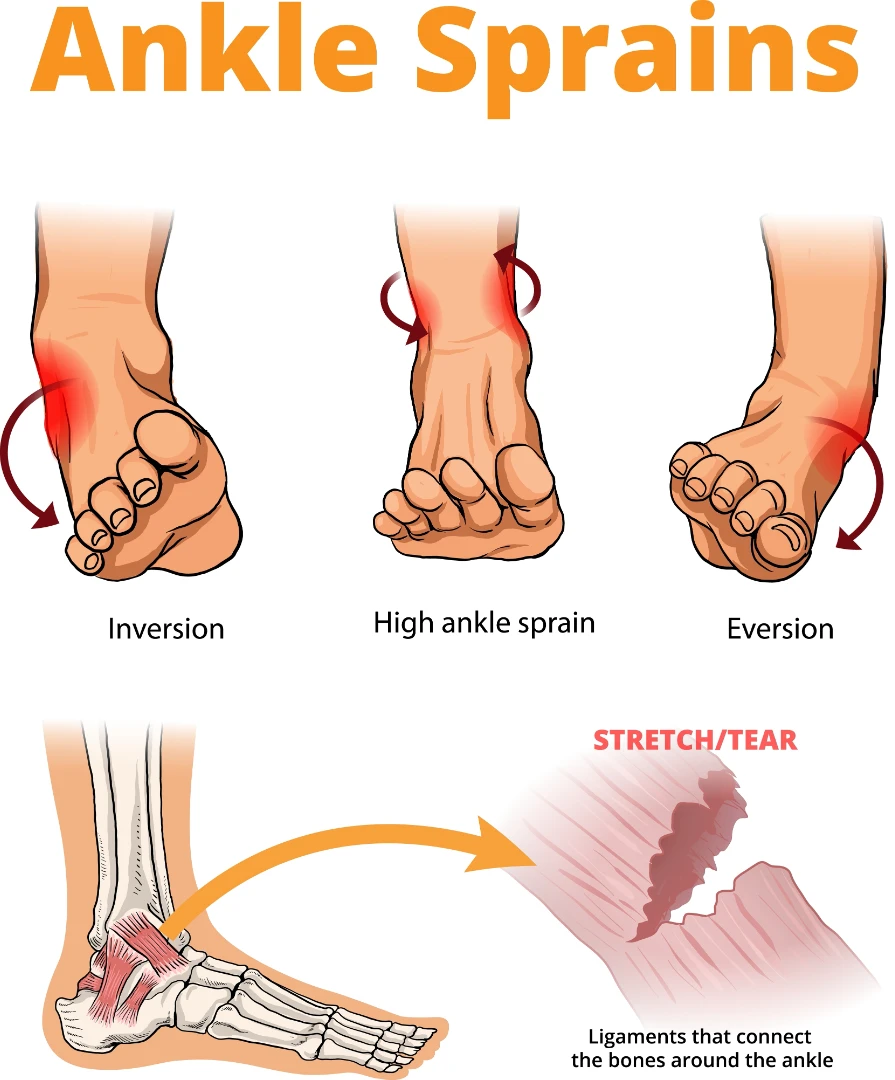Ankle
Sprain
- Home
- Conditions We Treat
- Foot & Ankle
- Ankle Sprain

What is an
ankle sprain?
An ankle sprain is the most common foot injury that occurs when your ankle rolls, twists, or turns in an awkward way. This causes the ligaments—that are located on the outer side of the ankle—to stretch excessively, resulting in tears. The severity of the injury depends on the number of ligaments involved and the extensivity of the tears, which are categorised into 3 stages, namely:
- Grade 1 (mild ankle sprain): the ligaments are stretched slightly, which causes a small tear, resulting in minor swelling, and a slight tenderness.
- Grade 2 (moderate ankle sprain): the ligaments are not completely torn with manifestations of swelling accompanied by pain when moving.
- Grade 3 (severe ankle sprain): ligaments are completely torn resulting in severe swelling, pain, and difficulties in walking.
Additionally, there are 3 types of ankle sprains, which are:
- Inversion ankle sprains: ankle rolls inwards as the foot is twisted upwards.
- Eversion ankle sprains: ankle rolls outward with possible tearing of the deltoid ligaments.
High ankle sprains: tend to result in injuries to the ligaments that hold the 2 leg bones together, which are located on the top of the ankle.
What causes ankle sprain?
Ankle sprains occur because your ankles are forced to move from their normal position with excessive force. This causes the ligaments to stretch beyond their limit, resulting in either a partial or complete tear. Some of the activities that can cause these tears are:
- A fall that results in an ankle twist.
- Landing awkwardly on your foot while jumping, running, or conducting any physical activities.
- Losing balance.
- Participating in sports that require a lot of ankles rolling, or twisting, such as tennis, basketball, and football.
- Walking, falling, or tripping on uneven surfaces.
- Wearing ill-fitted or high-heeled shoes.
Who is at risk of ankle sprains?
Although ankle sprains are the most common sports-related injury, there are a group of people who are more susceptible to it, including:
- Age: Adolescents stand a higher possibility of suffering from an ankle sprain due to their still-developing musculoskeletal system compared to adults.
- Athletes: athletes are more likely to have an ankle sprain, especially in sports that require a lot of ankle movements, such as sprinting, tennis, and basketball.
- Frequently wearing high-heeled shoes: if you frequently wear high-heeled shoes, then you have a higher risk of experiencing an ankle sprain as it stresses the muscles and the tendons.
- Gender: although ankle sprains are common across both genders, they are more common among women due to the fact that their ankles are more lax compared to men.
- Improper footwear: you have an increased risk of sustaining a sprained ankle if you wear shoes that are ill-fitted, especially when engaging in sports, exercises, or any physical activities.
- Poor physical condition: your chances of having an ankle sprain are higher when you have poor ankle flexibility and strength, especially when participating in sports, or physical activities.
- Prior ankle injuries: if you have previously experienced an ankle injury, such as an ankle fracture, you are more likely to develop a sprained ankle in the future.
- Uneven surfaces: regularly walking, running, exercising, or even playing sports on uneven surfaces puts you more at risk of suffering from a sprained ankle.

What are the symptoms of an ankle sprain?
An ankle sprain will exhibit some of the following symptoms:
- Bruising.
- Difficulties in walking, or standing.
- Instability in the ankle.
- Limited range of movement.
- Pain, especially with pressure.
- Popping sound or sensation when the injury occurs.
- Redness or warmth.
- Swelling above or below the ankle.
- Tenderness near the injured area.

How are ankle sprains diagnosed in Singapore?
Ankle sprains may require one or more diagnostic approaches;
- Physical examination: an orthopaedic specialist will physically assess your condition by identifying your range of motion, determining the severity of the pain at the ankle and determining the points of tenderness through palpitation.
- Computed Tomography (CT) scan: a CT scan is used to obtain more detailed images and information regarding the bones of the joint.
- Magnetic Resonance Imaging (MRI): an MRI is used to produce detailed 3D images of the structures of the ankle, specifically the ligaments.
- Ultrasound: an ultrasound is used to produce real-time images of the ligaments, and tendons from different angles.
- X-ray: An X-ray is used to produce images of the ankles’ bones.
How are ankle sprains treated in Singapore?
Treatment for an ankle sprain will depend on the severity of the injury. The primary goals of treating sprained ankles are:
- To reduce inflammation, swelling, and pain.
- To encourage healing of the injured ligament.
- To restore the functions of the ankle.
The RICE approach is typically preferred as the initial treatment method and as a conservative approach before introducing any invasive treatment options;
- Rest: refrain from engaging in activities that stimulate pain, discomfort, or swelling.
- Ice: using an ice pack for 15 to 20 minutes, with a 3-hour interval between each session to reduce swelling and inflammation.
- Compression: wrapping your injured ankle with an elastic bandage will help reduce the swelling, but not too tight as it could hinder blood circulation.
- Elevation: elevating your ankle above your heart level will help reduce swelling.
Beyond the RICE approach, our orthopaedic specialist may also incorporate additional treatment methods to promote optimal healing, which can include:
- Medications: you may be may prescribed oral medications to help alleviate the pain such as ibuprofen, naproxen sodium or acetaminophen. Analgesics will be considered in more severe pain conditions.
- Devices: to help reduce unnecessary pressure on the injured ankle, you may be prescribed specialised devices such as ankle support braces, crutches, walking boots or elastic bandages– this will depend on the severity of your injuries.
- Physical Therapy: after the swelling and when pain has reduced, you may be recommended physical therapy to rebuild your ankle’s strength, and restore its range of motion, flexibility, and stability.
- Surgery: although extremely rare, surgeries are often recommended in the event the injuries do not heal despite prior treatments or if rehabilitative exercises do not improve your condition. Surgery typically entails repairing a ligament that shows no signs of healing or reconstructing a ligament from a nearby tendon or ligament.
An ankle sprain can greatly reduce your quality of life. Delayed treatment may result in chronic ankle pain, chronic ankle joint instability, and arthritis in the ankle joint. If you have noticed pain around your ankles, reduced range of motion or swelling, get in touch with us to have it examined.
Frequently asked questions
Is an ankle sprain like an ankle fracture?
No, ankle sprains and ankle fractures are two different conditions. An ankle sprain involves a torn ligament, whereas an ankle fracture occurs when one or more of the ankle bones are broken or fractured. While both conditions share similar symptoms and causes, ankle sprains have a quicker recovery time. Meanwhile, it may take up to 6 weeks or more for a fractured ankle to heal.
How long does it take to recover from an ankle sprain?
There is no fixed timeline when it comes to recovering from a sprained ankle. Each patient will have a different duration as it depends on several factors, such as the severity of the injury, and the patient’s recovery rate. However, it approximately takes 2 weeks to heal from a minor ankle sprain, while a severe ankle sprain may take between 6 and 12 weeks to heal.
How long does ankle swelling last?
Swelling typically lasts between 2 and 3 days. However, if it lasts longer than a week, then it warrants an immediate visit to orthopaedics as it could indicate a severe ankle sprain or a broken ankle.
Do ankle sprains heal on their own?
Yes, most ankle sprains do heal on their own. However, they need help with regards to rebuilding their strength to prevent future injuries and to ensure that they heal properly. As such, it is important to seek medical attention whenever you have an ankle sprain, regardless of how minor or severe the injury is.
Can I still walk with a sprained ankle?
In most cases, you may be recommended to use crutches to avoid unnecessary pressure (from walking or even standing) on the sprained ankle. This will facilitate recovery. However, this will depend on your doctor’s discretion.
Why is it important for me to see an orthopaedic for a sprained ankle rather than a general practitioner?
An orthopaedic doctor is well-trained in treating injuries and diseases related to the musculoskeletal system, which includes the feet. They can provide tailored pain management that focuses on reducing inflammation and treatment that optimises healing without harming your joint health.
How can I tell if my ankle is sprained?
The tell-tell signs of a sprained ankle are that you twisted your ankle, which causes bruising, swelling, pain, and reduces your ability to walk.
How can I prevent a sprained ankle?
Some of the preventive measures that you can take to lower your risks of getting sprained ankles are:
- Exercising regularly to maintain optimum muscle strength.
- Refraining from walking, running, exercising, or partaking in any sports or physical activities on uneven surfaces.
- Slow down when you start to feel tired or experiencing any discomfort during exercises, sports, or physical activities.
- Warm up before engaging in any exercises, sports, or physical activities.










